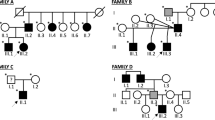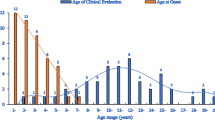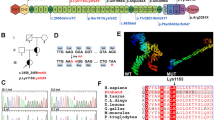Summary
The X-linked gene responsible for Duchenne muscular dystrophy encodes dystrophin, a high-molecular-weight cytoskeletal protein. Studies in several laboratories have revealed deletion of one or more exons in 60% of affected boys; quantitative analysis in our laboratory has detected duplication of exons in another 6%. The severe Duchenne phenotype is associated with deletions or duplications that shift the reading frame of the message, whereas the milder Becker muscular dytrophy is associated with deletions or duplications that maintain the reading frame. Patients who have neither deletion nor duplication may have nonsense mutations, one of which has been detected by predicting the site of the mutation from the size of the truncated protein. Rare females with the disease have a translocation that disrupts the dystrophin gene on one X chromosome and causes non-random inactivation of the normal X, resulting in the expression of the disease.
The high frequency of new mutation provides an opportunity to study the mechanism of chromosomal rearrangement that is characteristic of the disease. Our laboratory has focused on the translocations in females and on duplications in affected males. The X-autosome translocations of affected females are allde novo events that originated in the paternal set of chromosomes. Molecular characterization of the translocation junctions revealed reciprocal translocation with both deletion and addition of nucleotides at the junction, suggestive of a breakage and reunion mechanism. Duplications studied to date are all tandem in nature and sequence analysis of duplication junctions has revealed both homologous and non-homologous recombination. Marker segregation analysis has revealed that five out of five duplications originated in a single X chromosome of one of the maternal grandparents, suggesting that the recombination event is unequal sister chromatid exchange.
Similar content being viewed by others
References
Brooke MH, Fenichel GM, Griggs RC et al (1989). Duchenne muscular dystrophy: Patterns of clinical progression and effects of supportive therapy.Neurology 39:475–481.
Bodrug SE, Ray PN, Gonzalez IL, Schmickel RD, Sylvester JE, Worton RG (1987). Molecular analysis of a constitutional X-autosomal translocation in a female with muscular dystrophy.Science 237:1620–1624.
Bodrug SE, Burghes AHM, Ray PN, Worton RG (1989). Fine mapping of four constitutive translocations at the 5′ end of the Duchenne muscular dystrophy gene.Genomics 4:101–104.
Bodrug SE, Holden JJA, Ray PN, Worton RG (1991). Molecular analysis of X-autosome translocations in females with Duchenne muscular dystrophy.EMBO J 10:3931–3939.
Bulman DE, Gangopadhyay SB, Bebchuck KG, Worton RG, Ray PN (1991). Point mutation in the human dystrophin gene: Identification through Western blot analysis.Genomics 10:457–460.
Campbell KP, Kahl SD (1989). Association of dystrophin and an integral membrane glycoprotein.Nature 338:259–262.
Emery AEH (1987).Duchenne Muscular Dystrophy. Oxford Monographs on Medical Genetics No. 15. Oxford: Oxford University Press.
Hoffman EP, Brown RH, Kunkel LM (1987). Dystrophin: The protein product of the Duchenne muscular dystrophy locus.Cell 51:919–928.
Hu X, Burghes AHM, Bulman DE, Ray PN, Worton RG (1989). Evidence for mutation by unequal sister chromatid exchange in the Duchenne muscular dystrophy gene.Am J Hum Genet 44:855–863.
Hu X, Ray PN, Worton RG (1991). Mechanisms of tandem duplication in the Duchenne muscular dystrophy gene include both homologous and nonhomologous intrachromosomal recombination.EMBO J 10:2471–2477.
Karpati G, Pouliot Y, Zubrzycka-Gaarn E et al (1989). Dystrophin is expressed inmdx skeletal muscle fibres after normal myoblast implantation.Am J Pathol 134:27–32.
Koenig M, Monaco AP, Kunkel LM (1988). The complete sequence of dystrophin predicts a rod-shaped cytoskeletal protein.Cell 53:219–228.
Monaco PA, Kunkel LM (1988). Cloning of the Duchenne/Becker muscular dystrophy locus. In Harris H, Hirschorn IH, eds,Adv Hum Genet 17:61–98.
Partridge TA, Morgan JE, Coulton GR, Hoffman EP, Kunkel LM (1989). Conversion ofmdx myofibres from dystrophin-negative to -positive by injection of normal myoblasts.Nature 337:176–179.
Worton RG, Thompson MWT (1988). Genetics of Duchenne muscular dystrophy.Annu Rev Genet 22:601–629.
Zubrzycka-Gaarn EE, Bulman DE, Karpati G et al (1988). The Duchenne muscular dystrophy gene product is localized in the sarcolemma of human skeletal muscle.Nature 333:466–469.
Author information
Authors and Affiliations
Rights and permissions
About this article
Cite this article
Worton, R.G. Duchenne muscular dystrophy: Gene and gene product; mechanism of mutation in the gene. J Inherit Metab Dis 15, 539–550 (1992). https://doi.org/10.1007/BF01799613
Issue Date:
DOI: https://doi.org/10.1007/BF01799613




